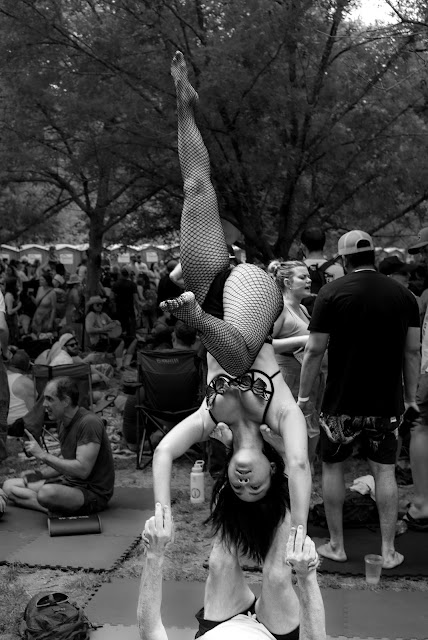In the Fall of 2020 I produced a three hour, online, live broadcast, fund-raising video show for a local theater. I wanted the show to be a three camera set up and since the "talent" was competent for live theater but not for a live production I wanted the main, center camera set up with a large teleprompter. All three cameras ( Two Panasonic S1 cameras and one Panasonic S1H camera ) Were run into a digital video switcher so our editor could switch between the three camera views on the fly. The two talents were miked with lavaliere microphones and we could also cut away during the show to pre-recorded video performances to spice things up. To aid the flow.
When you are running three cameras in a live production it's pretty critical that all three cameras stay up and running for the duration. Sure, we could watch each camera closely and run over to change the internal camera batteries as needed but that's a "high anxiety" method of production and the chances of failure are high. We chose camera video codecs that would neither overheat nor overtax the cameras and which would not run into program time limitations. 1080p was the perfect choice.
To make all three cameras run reliably for over three hours I made the decision to outfit each camera (positioned on tripods) with an Anker battery pack of its own. Each battery pack could deliver, through the USB port of the cameras, about 21,000 milliamperes of energy, or about ten times more power than a typical in camera battery. Since the cameras had been used before in video set-ups I was reasonably sure that we would have between six and eight hours of runtime --- if we needed it. At some point we decided to add Velcro to both the battery and a leg of each tripod so the power banks could rest safely very close to the cameras. At the same time a cable with some slack kept the power bank from interfering with horizontal adjustments to each camera on each tripod.
At the end of the program I breathed a sigh of relief. Everything worked as planned. And, the client was able to raise nearly $300,000 in one evening which was sorely needed in that particular period, in which live theaters were so hard hit. No audience? No income.
That experience was one of several that opened my eyes to the value of having several power banks in the studio inventory. On another occasion, during the big ice storm that hit Texas in 2021 our son was staying with us and was working on a big project for his new employer. He was working from home since the roads were impassable. Everything was going well until the power went out and his laptop slowly ran out of juice. Added to that our A/C powered wifi router was also disabled by the outage.
Power Banks to the rescue. Ben was able to work through the rest of the day and the power was back on here by morning. As soon as the power came back I recharged the power bank --- just in case. Also, he used his phone to create a wifi hotspot and that sucks down phone power. Power Bank #2 to the rescue.
My Leica SL2 is rechargeable through its USB but the SLs are not. Nor is the Q2. But I have a NiteCore charge for Leica SCL-4 and 6 batteries and it's USB-c powered. I bring a battery bank and the small charger on every remote location; even if I have a box full of already charged camera batteries. Just a little extra insurance.
What I would really like is to be able to connect a power bank to my battery powered electronic flashes in order to extend their on time during long shooting days and also to make up for the power lost to their incorporated LED modeling lights. With a bank for each flash one could shoot hundreds and hundreds of full power flash photographs and the only caveat would be to watch for the flashes overheating.
My older banks are workhorses but the one thing the older ones lack is PD. PD stands for Power Delivery and it's a newer standard that allows PD enabled devices (most current iPhones and some Android phones as well as some Apple and Dell laptops and iPadPros) to charge much more quickly. The bank can deliver a higher constant stream of power to the device without damaging it. My newest power bank, the Anker Power Core 26800 mAh PD unit has, as its name suggests, Power Delivery capability. (This is not an affiliate link and I don't care if you buy a power bank or not.... suit yourself).
I hadn't thought much about power banks recently but yesterday I got a call from my favorite Architectural Photographer and we had a conversation about extra batteries for his new 100 megapixel Fuji medium format camera. He uses it attached to an Atomos monitor so he can work quickly and with great mobility while also being about to show work in progress to his clients. Inevitably, in a client-rich environment, the camera gets left on and in review mode for long periods of time. And, of course, the 100 megapixels use more power per shot than a lower resolution camera would.
We discussed various powering options and I mentioned that I routinely charge the battery in my Fuji GFX 50Sii via the camera's USB port. Sometimes it's helpful when going from location to location on jobs --- or for more fun shoots. It's always worked well for me....
I have a feeling my friend will quickly acquire one, and will equally quickly take my recommendation and rig up some Velcro for quick attachment of the bank to a tripod leg. I just makes sense.
In this age of questionable power, and also more and more requests for shoots in remote locations, it's inevitable that we'll want ample reserves of solid, camera and light feeding voltage in our kits. And, as a blogger it's (ha! ha!) mission critical for my laptop to be always up and running. You never know when inspiration will strike and you have to be ready.
So, for running power hungry video cameras to keep mission critical laptops alive and humming; for charging your Apple Watch, for keeping LED lights running as long as you need them, for charging camera batteries at your remote campsite, these devices are really nice to have.
Nope, they won't run your air conditioners, your washing machine and especially not your clothes driers. They won't power jackhammers, or power saws, or that old set of Broncolor studio strobes that every English blogger relies on for their very existence. But for all the nice, useful and well designed gadgets we tend to fill our live with they can be nearly indispensable. About $75 with 60 Watt PD charger.
Just my thoughts on it. Yours will probably be vastly different. Fire away.










































































